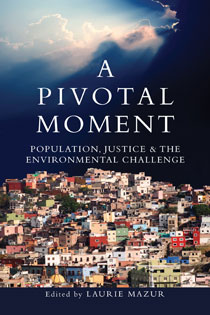
A Pivotal Moment
Population, Justice, and the Environmental Challenge
432 pages
6 x 9
21 illustrations

432 pages
6 x 9
21 illustrations
Through a series of essays by leading demographers, environmentalists and reproductive health advocates, A Pivotal Moment offers a new perspective on the complex connection between population dynamics and environmental quality. It presents the latest research on the relationship between population growth and climate change, ecosystem health and other environmental issues. It surveys the new demographic landscape—in which population growth rates have fallen, but human numbers continue to increase. It looks back at the lessons learned from half a century of population policy—and forward to propose twenty-first century population policies that are sustainable and just.
A Pivotal Moment puts forth the concept of “population justice,” which is inspired by reproductive justice and environmental justice movements. Population justice holds that inequality is a root cause of both rapid population growth and environmental degradation. As the authors in this volume explain, to slow population growth and build a sustainable future, women and men need access to voluntary family planning and other reproductive health services. They need education and employment opportunities, especially for women. Population justice means tackling the deep inequities—both gender and economic—that are associated with rapid population growth and unsustainable resource consumption. Where family planning is available, where couples are confident their children will survive, where girls go to school, where young men and women have economic opportunity—there couples will have healthier and smaller families.
"Here's the book on population we've been waiting for—not a nativist screed that lays the blame for our environmental woes on overbreeding others, but a clearheaded and smart look at the ways that justice, anti-materialism, and women's rights can help limit both our numbers and their impact."
Bill McKibben, author of "The End of Nature" and "Deep Economy"
"This book, with chapters by world-renowned experts, should be recommended reading for national and global leaders who seek to meet the environmental and economic development challenges of the 21st century. It provides a compelling, evidence-based case to support renewed attention to reproductive health and rights as a critical part of the solution to build a better and more sustainable future for all."
Geeta Rao Gupta, president, International Center for Research on Women
"Finally, a book that maps the complex connections among climate change, resource depletion, globalization, inequity and overconsumption, then focuses in on the ways that population growth exacerbates all of them, but also results from them. No simple-minded solutions are offered in this revelatory work; but an effective formula for reducing population impacts by strengthening women's rights, roles and economic opportunities. This book should be mandatory reading not only in academia, but for all public policy advocates seeking sustainable pathways for the future."
Jerry Mander, founder and distinguished fellow, International Forum on Globalization
"A Pivotal Moment demonstrates the possibility of building a sustainable, more equitable future... People count and numbers matter—and this book is a classic call to action we cannot afford to ignore if we care about the well being of current and future generations."
Dr. Gill Greer, director-general, International Planned Parenthood Federation
Foreword
Introduction
PART I. The Numbers
Chapter 1. Human Population Grows Up \ Joel E. Cohen
Chapter 2. The Largest Generation Comes of Age \ Martha Fransworth Riche
Chapter 3. People on the Move: Population, Migration, and the Environment \ Susan Gibbs
Chapter 4. The Urban Millennium \ United Nations Population Fund
PART II. The Impact
Chapter 5. Climate Change and Population Growth \ Brian C. O'Neill
Chapter 6. Fair Weather, Lasting World \ Robert Engelman
Chaper 7. Adapting to Climate Change: The Role of Reproductive Health \ Malea Hoepf Young, Elizabeth L. Malone, Elizabeth Leahy Madsen, and Amy Coen
Chapter 8. Population Growth, Ecosystem Services, and Human Well-Being \ Lynne Gaffikin
Chapter 9. Numbers Matter: Human Population as a Dynamic Factor in Environmental Degradation \ John Harte
Chapter 10. Environmental Justice in an Urbanizing World \ Gordon McGranahan
Chapter 11. The New Economics of Population Change \ Rachel Nugent
Chapter 12. Food: Will There Be Enough? \ Lester R. Brown
Chapter 13. Understanding the Global Food Crisis: Malthusian Nightmare or Free-Trade Fiasco? \ Walden Bello
Chapter 14. How Much Is Left? An Overview of the Water Crisis \ Eleanor Sterling and Erin Vintinner
Chapter 15. The Biggest Footprint: Population and Consumption in the United States \ Vicky Markham
Chapter 16. Population Growth, Reproductive Health, and the Future of Africa \ Dr. Fred T. Sai
Chapter 17. Cancún: Paradise Lost \ Adriana Varillas
Chapter 18. The Flip Side: How the Environment Impacts Our Reproductive Health \ Charlotte Brody and Julia Varshavsky
PART III. Looking Back, Moving Forward
Chapgter 19. Cairo: The Unfinished Revolution \ Carmen Baroso and Steven W. Sinding
Chapter 20. The New Population Challenge \ Judith Bruce and John Bongaarts
Chapter 21. Rethinking U.S. Population Policy \ Suzanne Petroni
Chapter 22. Going to Extremes: Population Politics and Reproductive Rights in Peru \ Susana Chávez Alvarado and Jacqueline Nolley Echegaray
Chapter 23. Mobilizing Constituencies to Achieve Sexual and Reproductive Health and Rights for All \ Adrienne Germain
Chapter 24. Women at the Center \ Ellen Chesler
Chapter 25. Taking Stock: Linking Population, Health, and the Environment \ Roger-Mark DeSouza
Chapter 26. From Crisis to Sustainability \ James Gustav Speth
PART IV. Thoughts for the Journey
Chapter 27. Reproductive Rights Are Human Rights \ Jacqueline Nolley Echegaray and Shira Saperstein
Chapter 28. Over-Breeders and the Population Bomb: The Reemergence of Nativism and Population Control in Anti-Immigration Policies \ Priscilla Huang
Chapter 29. Christian Perspectives on Population Issues \ Rev. Dr. James B. Martin-Schramm
Chapter 30. Ecomorality: Toward an Ethic of Sustainability \ Ursula Goodenough
Chapter 31. Reconciling Differences: Population, Reproductive Rights, and the Environment \ Frances Kissling
Afterword: Work for Justice! \ Laurie Mazur and Shira Saperstein
Index
If a tree falls in the forest, what does it cost?
From the perspective of federal disaster assistance, the answer traditionally has been “not much.” But now — thanks to improved number-crunching — the federal government is taking nature into account when it tallies the cost of disasters.
And, even more importantly, it is recognizing the value of nature — forests, wetlands, parks — in preventing or mitigating disasters.
Remember the Rim Fire, which incinerated a 400-square mile swath of California near Yosemite in 2013? When the state of California first asked the Federal Emergency Management Agency (FEMA) for a “major disaster” declaration, it was turned down. Why? Because most of the damage was inflicted on forests, rather than man-made structures — and there was no way to put a price-tag on that loss.
Just think: a backyard shed gets destroyed by fire, that’s a $2,000 loss.
But when 77,000 acres of Yosemite National Park are reduced to smoking embers? Nada.
Enter Earth Economics, an independent non-profit that helps decision makers assess the financial value of natural systems. The group’s economists looked at the services the forest provided — filtering drinking water for the City of San Francisco, preventing floods, sequestering carbon, providing recreational opportunities — and calculated the dollar value of what was destroyed by the fire.
Armed with those numbers, Governor Brown appealed FEMA’s decision — and won.
Fast forward to 2016. The once-radical notion of valuing nature’s services is now more widely accepted by the federal government. Recently, the U.S. Department of Housing and Urban Development (HUD) awarded $1 billion to 13 communities through the National Disaster Resilience Competition (NDRC) — and actually required applicants to calculate the value of nature and other non-traditional benefits in their proposals.
The competition asked applicants to use a holistic benefit-cost analysis developed by Earth Economics with support from The Kresge Foundation, which incorporates natural ecosystems’ value and services, long-term environmental sustainability, and community benefits such as health and employment. Earth Economics provided training, tools, and resources throughout the competition to help applicants calculate those values.
“The Earth Economics team helped us to capture the full range of benefits of the Community and Watershed Resilience Program, including the tremendous ecological benefits that it will provide not just to Tuolumne County, but to the State as a whole,” said Louise Bedsworth, Deputy Director of the California Governor’s Office of Planning and Research.
The winning proposals all make use of natural systems to build resilience to climate change impacts and other disasters. For example:
Recognizing the value of nature and other overlooked social and economic benefits simply drives better decision making, according to David Batker of Earth Economics, who helped coach a number of the NDRC’s winning applicants.
“Benefit-cost analysis that includes nature helps us make smarter investments at federal, state, and local levels,” said Batker. “We owe it to ourselves and future generations to use this tool to identify the best, most robust and resilient investments.”
Indeed, investing in nature produces a bigger bang for the buck. For example, on a good day, the Lower Manhattan greenway is a park and bike path; on a bad day, it protects the city by absorbing potentially deadly storm surges. That is more than you can say for most single-purpose “gray” infrastructure, such as concrete levees.
Investing in natural infrastructure is a good way to get the most from taxpayers’ money, says Harriet Tregoning, Principal Deputy Assistant Secretary for HUD’s Office of Community Planning and Development.
“We are learning together about how to encourage a broader range of benefits from every federal dollar that gets expended,” Tregoning said during an announcement of the NDRC winners.
Valuing nature may seem like a no-brainer to many; the majestic forests of Yosemite obviously have tremendous value. But, too often, our public policies are structured by rules developed back when natural resources seemed inexhaustible. As the economists say, “you get what you measure.”
When we fail to measure the economic value of nature, we treat it as expendable. That is why the United States — one of the most resource-rich countries in the world — is now running an ecological deficit, according to the Global Footprint Network.
So, nature counts for more than pretty postcards and vacations. New tools to measure the dollars-and-cents impact of nature help planners, officials and taxpayers make the wisest choices for both the planet’s people and the natural systems that support them.
It can seem like every news story spells bad news for the environment—from the ongoing clean water crisis in Flint, Michigan to Earth's hottest summer ever recorded. But it's not all doom-and-gloom. With so many dedicated people working on environmental issues, there are also stories of hope. We asked Island Press authors to share good news in their field. Check out the inspiring stories they shared below and if you know of other environmental success stories, share them in the comments.
 Abbie Gascho Landis, author of Immersion:
Abbie Gascho Landis, author of Immersion:
Last summer, mussel biologists and crew worked to relocate over 100,000 mussels, many federally protected, prior to the construction of the I-74 bridge over the Mississippi River. There's also the creation of the Fairmount Water Works' Mussel Hatchery in Pennsylvania, and the proposed listing of the yellow lance mussel as a threatened species under the Endangered Species Act. While it's sad that the mussel needs to be listed, the act of listing it means that its habitat (which is significant!) might benefit from more protections. Better to list a declining species than to ignore it. There's also this video of mussel sexy time, which is awesome, if not newsy.

Laurie Ann Mazur, editor of the Urban Resilience Project and Resilience Matters:
Left behind by the globalized economy, Buffalo New York has lost more than half its population since 1950. By 2005, when the community group People United for Sustainable Housing (PUSH) Buffalo was founded, West Side residents were struggling with unemployment, rampant blight and high energy costs.
At that time, there were an estimated 23,000 vacant homes in Buffalo. PUSH took on a state housing agency that was using vacant buildings to speculate on Wall Street, and got the buildings turned over to the community—with funding to fix them up. Next, PUSH brought together hundreds of community residents to craft a plan for a large, blighted area. The result is a 25-square block Green Development Zone (GDZ) that is now a model of energy efficient, affordable housing. PUSH and its non-profit development company rehabilitate homes in the GDZ, installing efficiency upgrades like insulation and geothermal heating that dramatically lower residents’ utility bills. PUSH also won a New York State grant to build 46 new homes—including a “net zero” house that produces as much energy as it consumes.
The GDZ doubles as a jobs program. Through its construction projects, PUSH has cultivated a growing network of contractors who are committed to hiring locally. And PUSH successfully advocated for New York’s Green Jobs - Green New York program, which seeks to create 35,000 jobs while providing energy upgrades and retrofits for 1 million homes across the state.
Excerpted from an Urban Resilience Project piece in Yes! Magazine by Taj James and Rosa Gonzales

Carlton Reid, author of Bike Boom and Roads Were Not Built For Cars:
There have been a gazillion studies which say how cycling is good for public health, but one new one is a biggie—with a sample size of more than 250,000 Brits—and led to global media coverage. The Scottish study was published in the British Medical Journal and, staggeringly, it said cycling to work lowers the risk of dying by 40 percent. If medical science created a pill with that sort of impact it would be quickly bigger than Viagra! Cancer is a huge worry for the Western world, yet cycling to work halves your chance from dying from it. Amazing, really.
 Michael S. Carolan, author of No One Eats Alone:
Michael S. Carolan, author of No One Eats Alone:
If you go back to the first 100 years of this nation, our food system was built on people sharing seeds. That was, in fact, the *only* way new seeds were acquired—that and saving seeds from the prior year's harvest. Seed saving and sharing is not only becoming a lost art, it is also illegal in certain instances.
For example, take the case, from 2014, when the Pennsylvania Department of Agriculture informed a seed library in its state that they were in violation of a 2004 state law—the Pennsylvania Seed Act of 2004. The seed library, its officials were told, fell under the definition of a “seed distributor,” which meant they needed to start acting like one. That required that they meet stringent labeling requirements. The labels, which need to be in English, must clearly state the name of the species or commonly accepted name of kind of plant. If it is a hybrid plant, the label must explain something about whether the seed has been treated. Lastly, labels must include the name and address of the seed-sharing entity. As a seed distributor, the library was also told they must conduct germination and purity analyses.
On a more encouraging note: In September 2016, the Seed Exchange Democracy Act (Assembly Bill 1810) was signed into law in California. The bill amends the “seed law” chapter of the state’s Food and Agricultural Code thus exempting seed libraries from burdensome testing and labeling requirements.
The Sustainable Economic Law Center offers a toolkit of resources to help concerned citizens make the Seed Exchange Democracy Act a reality in their own state. It includes sample legislation, local resolutions, letters of support, and more.

Joy Zedler, co-author of Foundations of Restoration Ecology:
Restoration ecology and our book on its foundations support new pathways for restoring watersheds to protect wetlands. After decades of teaching conservation and restoration of ecosystems, I'm using the wisdom captured in our book to practice what I've been preaching. I'm one of the fortunate few who have wetlands in our back yards. I live near intact natural ecosystems among citizens who tax themselves so our township can purchase development rights and create conservation easements. The challenge is to extend voluntary approaches upstream to achieve watershed restoration goals and protect downstream wetland gems. The solution won't be top-down governance in this state—or in this country at the present time—but the solution could be bottom-up watershed-care based on strong science and wetland ethics.
Donald A. Falk, co-author of Foundations of Restoration Ecology
To me the really big and encouraging news is that ecosystem restoration is understood increasingly as a central component of global efforts to reverse anthropogenic climate change. This means that the streams of ecological restoration, ecosystem and biodiversity protection, and climate action are fusing, creating a powerful incentive to both protect and restore ecosystems which are absorbing at least a quarter of all GHG emissions annually (for an essay on this, see Ecosystems are critical to solving the global climate crisis).
